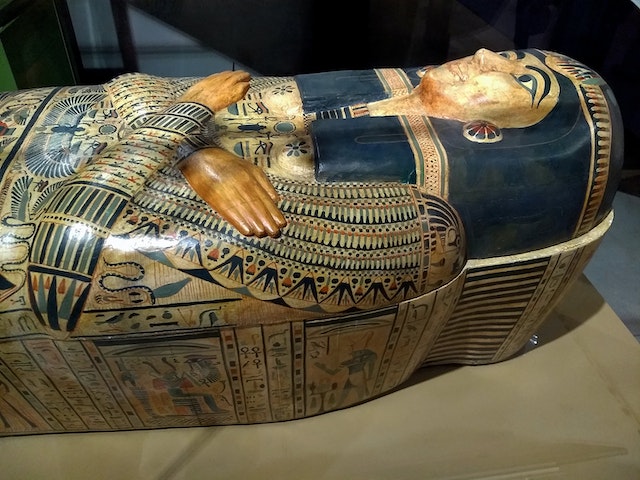
How many Egyptian dynasties were there? Depending on how you view it, there were 31, 33, or 34. Egypt was conquered by Alexander the Great in 332 BC, which made the 32nd and 33rd dynasties Greek. They still ruled Egypt, so some people count them as dynasties. Then, in 30 BC, Greek Egypt was conquered by the Romans and became part of the Roman empire. Some people count Roman Egypt as the 34th dynasty. The emperors were called pharaohs in Egypt, but they very rarely visited Egypt and the title of pharaoh died out by Emperor Maximus Daza in 314 AD.
The history of Egypt is complex, and the dynasties have been broken up into kingdoms to make it easier to talk about them. There are also intermediary periods where Egypt was in a time of upheaval. The first person to break the rulers of Egypt up into dynasties was an Egyptian priest called Manetho. He wrote the Aegyptica (a history of Egypt) in about 300 BC. He wrote in Greek.
The first two dynasties come in the Early Dynastic period, from 3150 BC to 2686 BC. People had been living along the Nile for thousands of years. They lived there before the Sahara Desert became a desert. By 3300 BC, the groups of people had coalesced into Upper and Lower Egypt. They both had kings and systems of government. Lower Egypt was more fertile, but Upper Egypt had a stronger government and leadership. There were frequent wars between the two civilizations until, in 3150 BC, Menes, the king of Upper Egypt, managed to take over Lower Egypt and united the country.
Dynasties three to six come in the Old Kingdom period, from 2687 BC to 2181 BC. Egypt came into its own during the Old Kingdom period and many of the buildings we know of ancient Egypt, such as the Great Pyramid at Giza were built during this time. The capital city was moved to Memphis, which was on the Nile, just south of Giza and modern-day Cairo. There was a long period of peace and prosperity during the Old Kingdom period, which meant the pharaohs were able to accumulate great wealth. For this reason, it is often called the “Age of Pyramids”.
In 2181, the Old Kingdom collapsed because of political problems, famine, civil disorder, and disease. The climate became drier, and the Nile shrank. It was a difficult time for Egypt, and this became the First Intermediate Period. There were still pharaohs, and the 7th to 10th dynasties ruled during this time, although they didn’t rule for very long and they went through four dynasties in about fifty years.
The First Intermediate Period ended in 2125 BC when Mentuhotep I reunified the country. This began the Middle Kingdom, 2130 to 1649 BC. And the 11th to 13th dynasties. There was relative peace again. The peace can be demonstrated because Egyptian writing peaked during this period and there were many literary works produced. It is often called the Second Golden Age of Egypt.
In 1650, a group of people called the Hyksos invaded and conquered most of Egypt. They set themselves up as rulers and this began the Second Intermediate Period, which would last for about 100 years and comprise the 14th to 17th dynasties. The Hyksos took over most of northern Egypt and the Egyptian pharaohs were pushed to the south. They stayed there, holding an uneasy truce, until 1550 BC when Ahmose, the first pharaoh of the 18th dynasty expelled the Hyksos and retook all of Egypt. He also managed to expand their territory into Palestine and Syria.
The next period was the New Kingdom period and it is known as the third and the last golden period. It lasted from 1550 BC to 1077 BC and was ruled by the 18th to 20th dynasties. Rameses III was pharaoh during the 20th dynasty, and he was probably the peak of the Egyptian empire. It was a slow decline after that.
The country collapsed again in 1069 BC and the Third Intermediate Period started. This lasted from 1069 to 747 BC and was ruled by the 21st to the 25th dynasties. This marks the time when Egypt was ruled by a series of foreign powers. At one point, there were two dynasties ruling at the same time.
The Nubians (from where Sudan is now) conquered Egypt in 780 BC and started the Late Period, which lasted to 343 BC. The 26th to the 31st dynasties ruled through this period. The Nubians settled Egypt down and reinstituted a lot of old customs. They brought stability and another era of peace. In 525, Egypt was conquered by Persia, and the 27th dynasty were Persian. Finally, in 399 BC, the Persians were overthrown and the 29th dynasty became the first Egyptian dynasty for a while. They didn’t last long.
In 332, Alexander the Great conquered Egypt and made it part of his Greek Empire. The 32nd and 33rd dynasties ruled Egypt throughout this time, but they were controlled by Greece. The last pharaoh of the 33rd dynasty was Cleopatra VII. She did her best to keep the country together, but they couldn’t stand up to the might of the Roman Empire and in 30 BC, Egypt became part of Rome. Cleopatra was the last pharaoh of a line of 33 dynasties that could be traced back over 3,100 years.
Rome took over Egypt and the emperors were also called pharaohs, although they didn’t visit Egypt and many of them didn’t even think about it. Still, the Roman pharaohs can be classed as the 34th dynasty. The title of pharaoh died out with them. And this is what I learned today.
Photo by Miguel Á. Padriñán: https://www.pexels.com/photo/blue-and-brown-egyptian-coffin-2076370/
Sources
https://en.wikipedia.org/wiki/Manetho
https://en.wikipedia.org/wiki/List_of_Roman_dynasties
https://en.wikipedia.org/wiki/Roman_pharaoh
https://study.com/learn/lesson/upper-lower-egypt-overview-unification.html
https://en.wikipedia.org/wiki/Dynasties_of_ancient_Egypt
https://discoveringegypt.com/ancient-egyptian-kings-queens/
https://discoveringegypt.com/ancient-egyptian-kings-queens/egyptian-old-kingdom-dynasties/
https://discoveringegypt.com/ancient-egyptian-kings-queens/egyptian-dynasties-middle-kingdom/
https://discoveringegypt.com/ancient-egyptian-kings-queens/egyptian-dynasties-new-kingdom/
https://en.wikipedia.org/wiki/Egyptian_language
https://www.bibalex.org/learnhieroglyphs/lesson/LessonDetails_En.aspx?l=9
